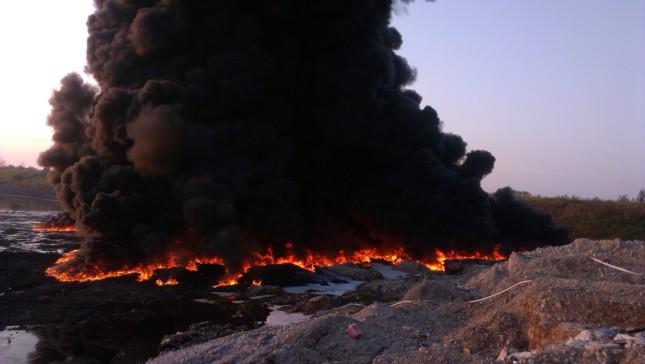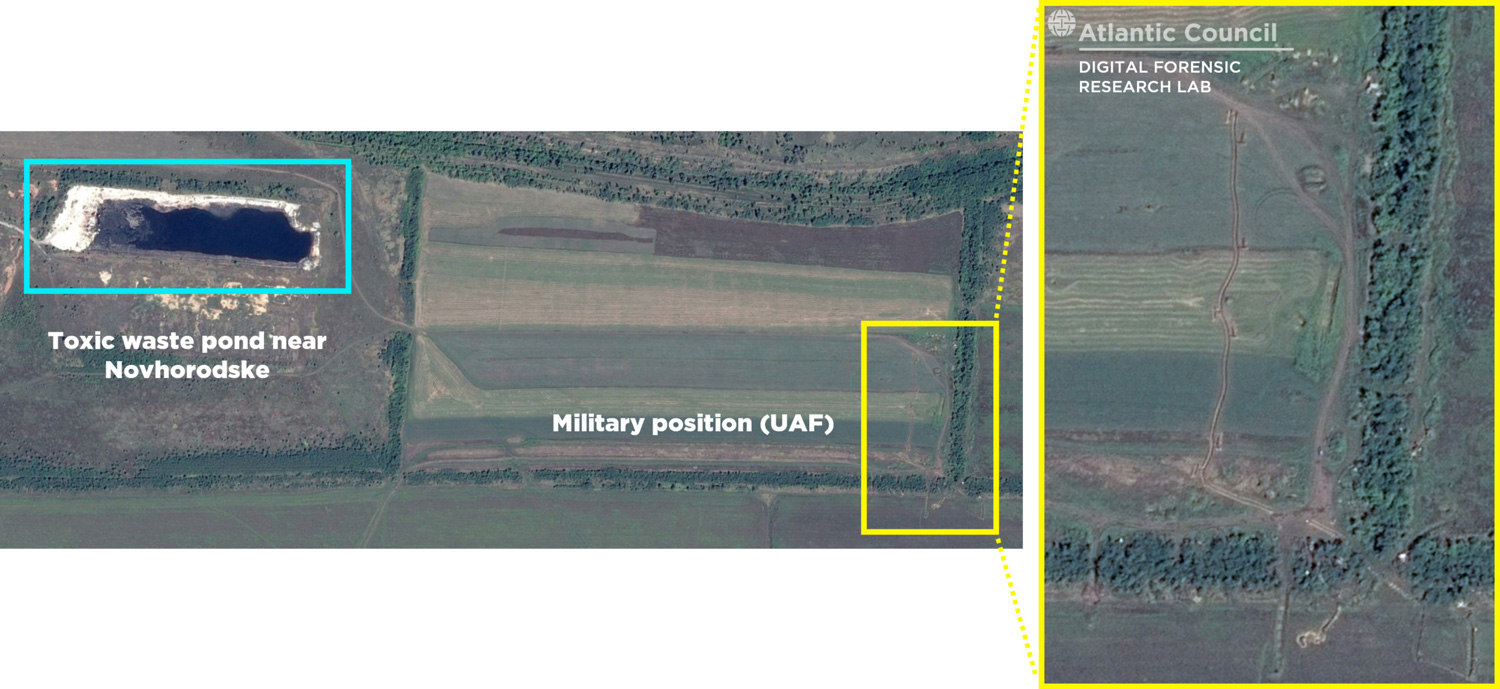-
A Ukrainian Stand-Off: The Toxic Consequences of Armed Conflict in Donbass
May 7, 2018 By Wim Zwijnenburg
A looming industrial tower of pipelines and chemical storage tanks rises out of snowy landscape. In Novogorodske, a small quiet town in eastern Ukraine, workers go about their daily business at the Dzerzhinsk Phenol Factory. A penetrating, inescapable smell greeted us as we entered the village, which a Dutch journalist and I are visiting as part of our investigation into the environmental and health risks from ongoing fighting in Eastern Ukraine. Our research for the open-source collective Bellingcat has identified the factory as one of a number of potential environmental flashpoints.
At the factory, the director welcomes us with coffee and an obligatory crash course in safety and chemical hazards. The plant turns coal tar into phenol, a toxic chemical used in pharmaceuticals and the plastics industry, and paraffin, which has numerous uses, from wax to rocket fuel. More than 350,000 liters of toxic waste is stored in three nearby ponds, just a couple of hundred meters outside the village. Locals tells us how the mafia used the ponds’ acid water to get rid of bodies. When we ask the director about it, he laughs and says it’s not that bad: “You only get heavy burn wounds when you touch the water.”
Since the outbreak of the conflict in 2014 between the Ukrainian army and Russia-backed separatists, the so-called “Donetsk People’s Republic,” the heavy industrialised Donbas region has faced an increased risk of ecological disaster. Shelling by both factions could release substantial pollution from the area’s many chemical factories, water treatment facilities, power stations, and others environmentally sensitive sites. One barrage of misfired artillery shells could set in motion a chain reaction that would render large parts of the region uninhabitable, spilling toxic waste into rivers and groundwater, making living there impossible.
For five days, we plow our way through the snowy landscape in a rusty, Soviet-era Lada, trying to understand how local villagers, factory owners, and the military perceive these threats. Do they know what could happen if one of the shells hit the wrong target? And how do they deal with the multitude of risks to their health?
Devastating Consequences: The Risk of Toxic Flooding
The Bakhmut Agrarian Union, near the town of Novoluhanske, is a giant livestock facility with 90,000 pigs and a huge reservoir of one million liters of animal waste, which contains high levels of nitrates, ammonia, and antibiotics. Damage to the facility, which has already been targeted by shelling, could release the waste into nearby rivers.
While we’re standing next the town’s local military post, we hear a heavy artillery barrage about 3 km away. The farm is literally on the frontline, surrounded by trenches. We pass several Ukrainian army roadblocks to reach the main office building. In the lobby, a big hole in the ceiling—and the visible remains of a Grad missile—marks the last hit in December 2017. The staff tells us that all the water-pumping systems have been fixed and unexploded ordnance cleared from the pond, so the biggest threat is gone. But that doesn’t exclude the risk of renewed shelling.
OSCE’s recent environmental assessment of the conflict in Ukraine portrayed a distressing situation. Due to power shortages and lack of trained personnel, dozens of coal mines are out of operation, affecting the pumping systems. These mines, some of which store toxic and radioactive waste, are at risk of severe flooding if the rising groundwater isn’t pumped out. If they flood into the rivers and nearby villages, the consequences would be catastrophic for local communities and the environment they depend on. Some scientists fear that hundreds of thousands of people would need to be evacuated, as happened in the past. The OSCE report highlights a range of other problems, including burned forests and damage to industrial facilities. In December 2017, the UN Commissioner on Human Rights warned of the ‘“devastating consequences” for the local population and environment, if water filtration stations, storing thousands of litres of chlorine, were hit by the shelling.
Building Stronger Norms to Prevent Conflict-Related Pollution
Conflicts like the ones in the Ukraine, Iraq, and Syria show how wartime damage to the environment can have long-term consequences for countries as they seek to recover. There are three main key concerns around conflict pollution that need to be addressed. First, awareness of how military activities can leave behind toxic remnants and the related environmental and human health risks is limited. The lack of sufficient efforts to identify and map potential environmental hotspots hinders effective humanitarian response and post-conflict reconstruction.
Second, states are not taking responsibility for the environmental footprint of their armed forces, from producing munitions to selecting targets, and are not sharing data with authorities and humanitarian organizations during and after armed conflicts. To improve transparency and accountability, states should share data and improve relevant practices that limited their environmental “bootprint.”
Third, targeting critical infrastructure or the collapse of environmental governance can have severe consequences for local populations: for example, a misfired artillery barrage could release toxic waste, contaminating water and displacing entire towns and villages. In Iraq and Syria, the pollution of rivers and agricultural lands from attacks on oil facilities has already hampered livelihoods and socio-economic opportunities for local communities. Therefore, military planning should include reviewing the direct or long-term consequences of targets and potential impacts on livelihood.
With more conflicts taking place in urban areas and near environmental flashpoints, there is a clear and outspoken need to incorporate these environmental security risks into military planning, humanitarian responses, and post-conflict reconstruction programs. The recent resolutions adopted by the United Nations Environmental Assembly—a 2016 resolution submitted by Ukraine on armed conflict and the environment and a 2017 resolution submitted by Iraq on mitigation of conflict pollution—as well as work done by the UN Special Rapporteurs on toxics and human rights and the International Law Committee on protection of the environment in armed conflict, together show the growing recognition that we need stronger international norms and regulations to address the toxic remnants of war and the environmental dimensions of conflict.
At the same time, there is increasing concern over the effects of environmental degradation on the potential for conflict. As wars degrade natural resources and agricultural lands, how does this impact shape people’s lives and livelihoods, and thus possible future conflicts? From our visit to the Donbass, we learned that the affected communities deserve a bigger voice in the wider debate on environmental pollution caused by armed conflict. Efforts to recover and rehabilitate after war should include addressing the acute and chronic health risks arising from damage to the community’s livelihoods. We must seize this opportunity to address these concerns and not only help prevent these challenges from getting worse, but also help the community build a better future for themselves and all of the victims of war.
Wim Zwijnenburg is the project leader for humanitarian disarmament at PAX, a Netherlands-based NGO focused on promoting peace. PAX was awarded the 2017 UNEP/UNOCHA Green Star Award in the Response category for its work on conflict and environment.
Sources: Bellingcat, Euromaiden Press, Gornyi Zhurnal, Hromadske, Organization for Security and Co-operation in Europe, Pax, Politico, United Nations Environment Programme, United Nations High Commissioner for Refugees, United Nations International Law Commission
Photo Credit 1: Evgeniy Didus, Director of the Phenol Factory. Not for reuse.
Photo Credit 2: Atlantic Council Digital Research Lab; Google Earth. Not for reuse.
 A Publication of the Stimson Center.
A Publication of the Stimson Center.




